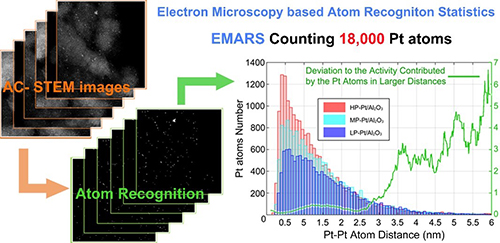| Sep 14, 2021 |
Identifying activity origin of single-atom catalyst through atom-by-atom counting
(Nanowerk News) Researchers led by Prof. LIU Wei from the Dalian Institute of Chemical Physics (DICP) of the Chinese Academy of Sciences and their collaborators developed a methodology of electron-microscopy-based atom recognition statistic (EMARS) to directly identify the activity origin of Pt/Al2O3 industrial reforming catalyst through atom-by-atom counting of over 18,000 Pt atoms.
|
|
This study was published in Journal of the American Chemical Society ("Identify the Activity Origin of Pt Single-Atom Catalyst via Atom-by-Atom Counting").
|
|
Atom dispersion in metal supported catalysts influences their catalytic activity, selectivity, and stability. Traditional spectroscopy methods can provide an averaged description about the atom dispersion, but they are not able to distinguish localized structure divergence.
|
|
The researchers re-defined the single-atom catalyst (SAC) dispersion through atom-by-atom counting with EMARS, and analyzed 18,000+ Pt atoms of Pt/Al2O3 catalyst at spatial range of 0.023 nm to 6 nm in aspects of precise statistics about the Pt-Pt distance and atom number contained in clusters.
|
 |
| Demonstration on advantages of EMARS for dispersion analysis of metal-supported catalyst. (Image: ZHANG Fan)
|
|
They found that the activity for aromatics production was quantitatively correlated with the density of the supported Pt1 single atoms, but not all Pt1 sites, only those with Pt-Pt distances larger than 0.38 nm could efficiently facilitate aromatic producing. Pt clusters contributed no direct activity.
|
|
"The clusters in mono-layer dispersion could be re-dispersed via oxidation, serving as adaptive source to kinetically provide Pt1 sites, whereas other crystalline clusters inversely behaved as nucleation sites for Pt atoms sintering," said Prof. LIU.
|
|
Building a model catalyst of high homogeneity to understand the activity origin is not only technically challenging but also time-consuming. This work offers the possibility to directly identify the catalysis roles of different metal species in a practical catalyst via atom-resolved statistics.
|

